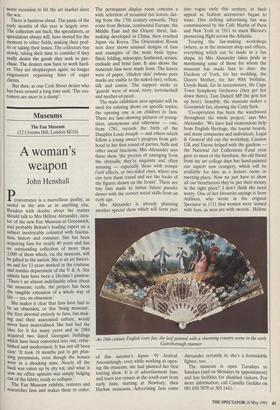Museums
The Fan Museum
(12 Crooms Hill, London SE10)
A woman's weapon
John Henshall
Perseverance is a marvellous quality, as useful in the arts as in anything else. Readers with doubts about the matter should talk to Mrs Helene Alexander, cura- tor of the new Fan Museum at Greenwich, and probably Britain's leading expert on a subject inextricably coloured with fascina- tion, history and romance. She has been acquiring fans for nearly 40 years and has an outstanding collection of more than 2,000 of them which, via the museum, will be gifted to the nation. She is an art histori- an and for 13 years worked at the costume and textiles department of the V & A. She admits fans have been a lifetime's passion: `There's an almost indefinable ethos about the museum; really, the project has been the tangible extension of a whole way of life — yes, an obsession.'
She makes it clear that fans have had to be an obsession, or this 'living museum', the first devoted entirely to fans, fan-mak- ing and their associated culture, would never have materialised. She had had the idea for it for many years and in 1984 acquired two listed Georgian buildings which have been converted into one, refur- bished and modernised. It has not all been easy: 'It took 18 months just to get plan- ning permission, even though the houses were in a shocking state. Nearly all the back was eaten up by dry rot, and what is now my office upstairs was simply bulging out of the fabric, ready to collapse.' The Fan Museum exhibits, restores and researches fans and makes them to order. The permanent display room contains a wide selection of mounted fan leaves, dat- ing from the 17th century onwards. They come from Britain, continental Europe, the Middle East and the Orient: there, fan- making developed in China, then reached Japan via Korea. The Orientation Room next door shows unusual designs of fans and examples of the main basic types: fixed, folding, telescopic, feathered, screen, cockade and brise fans. It also shows the materials fans were made from. The leaves were of paper, 'chicken skin' (whose pore marks are visible to the naked eye), vellum, silk and cotton. The support sticks or `guards' were of wood, ivory, tortoiseshell and mother-of-pearl.
The main exhibition area upstairs will be used for rotating shows on specific topics; the opening one is on children in fans. There are fans showing pictures of young- sters, anonymous and otherwise — one, from 1781, records the birth of the Dauphin Louis Joseph — and others which follow a young owner's progress from girl- hood to her first round of parties, balls and other social functions. Mrs Alexander says these show 'the process of emerging from the chrysalis; they're exquisite and often amusing — especially those with trompe l'oeil effects, or two-sided ones, where you can turn them round and see the backs of the figures shown on the fronts'. These are tiny fans made to imbue future grandes dames with the correct social skills from an early age. Mrs Alexander is already planning another special show which will form part An 18th-century English ivory fan, the leaf painted with a charming country scene in the early Gainsborough manner of this autumn's Japan '91 festival. Astonishingly, even while working at open- ing the museum, she had planned her first touring show. It is of advertisement fans, and tours ten venues in the south-east from early June, starting at Newbury, then Harlow museums. Advertising fans came into vogue early this century, as their appeal as fashion accessories began to wane. One striking advertising fan was commissioned by the Café Martin of Paris and New York in 1911 to mark Bleriot's pioneering flight across the Atlantic.
Touring the fan-making workshops (where, as in the museum shop and offices, everything which can be made in a fan shape, is) Mrs Alexander takes pride in mentioning some of those for whom the museum has made fans to date: the Duchess of York, for her wedding, the Queen Mother, for her 90th birthday, Lloyds Bank, for its tercentenary, the Cape Town Symphony Orchestra (they get hot down there), Tam Dalyell MP (he gets hot up here). Sensibly, the museum makes a Greenwich fan, showing the Cutty Sark.
`Co-operation has been the watchword throughout the whole project,' says Mrs Alexander. 'We have had tremendous help from English Heritage, the tourist boards, and many companies and individuals. Legal & General did out the workshop, Cannon UK and Fisons helped with the gardens the National Art Collections Fund even gave us most of the furniture. An old friend from my art college days has hand-painted our superb new orangery, which will be available for hire as a lecture room or meeting-place. Now we just have to show all our benefactors they've put their money in the right place!' I don't think she need worry. One of her favourite sayings is from Addison, who wrote in the original Spectator in 1711 that women were 'armed with fans, as men are with swords'. Helene Alexander certainly is; she's a formidable fighter, too.
The museum is open Tuesdays to Sundays (and on Mondays by appointment) and has facilities for disabled visitors. For more information, call Camilla Geddes on 081 858 7879 or 305 1441.


























































 Previous page
Previous page